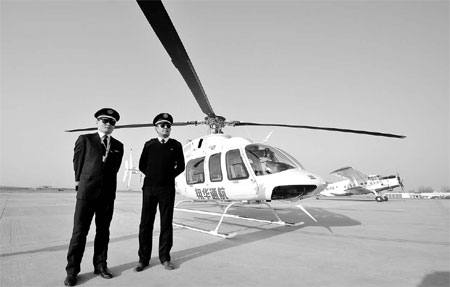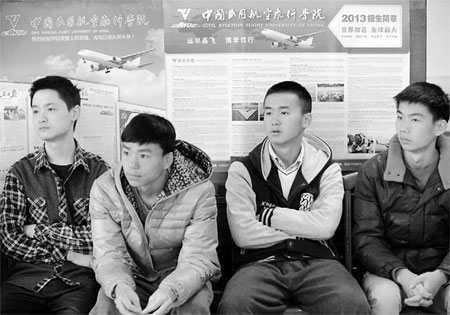Regulators look to boost development of private aviation sector, pilot reserve
For businessman Yuan Yongmin, waiting for the next buyer means being patient for several months or even a year.
"I have been waiting more than 20 years to send all of them to fly," the 58-year-old said, pointing at a row of Blue Eagle AD-200 ultralight planes in his hangar in suburban Beijing.
In 1993, Yuan, who has been a successful restaurant owner since the '80s, took out a 20 million yuan (then $3.5 million) loan and purchased the proprietary rights for the lightweight aircraft from the Nanjing University of Aeronautics and Astronautics.
He then established China's first private plane factory, which can produce as many as 100 aircraft per year.
However, his business hasn't been the success he had hoped - only 20 planes have sold in the past 20 years.
The current price for the two-seat aircraft is about 350,000 yuan ($57,900).
"Stringent application procedures for flying private planes and rigorous physical requirements for pilots have resulted in only a few people owning planes or having pilot's licenses," Yuan said, noting he supports the aircraft factory with the money he earns from the restaurant and other ventures.
"I hope the government's recent actions will boost my aircraft business by attracting more people to study flying and to buy their own planes and helicopters."
Yuan's hope for his business is due to China's move in the last few months to boost the private aviation industry.
Since late November, relaxed standards for comprehensive and physical exams have been instated for students seeking certification to fly private planes.
Under the new standards, those aged 17 or above who have received at least three years of middle school education are eligible to apply for a private pilot's license.
The biggest changes made to the previous requirements are in the physical criteria an applicant must meet.
Requirements for height, weight and eyesight were altered, and those who have chronic diseases, like diabetes, hypertension or coronary artery disease, which would disqualify them in the past, are allowed by the new rules.
"After the changes, the physical requirements for private pilot's license holders have become as flexible as those for drivers," the Civil Aviation Administration of China said in a statement.
"Before the standards were loosened, the physical requirements for private aircraft pilots were as stringent as those for commercial airline pilots," said Li Xiaojin, a professor at the Civil Aviation University of China.
"Because more and more people have begun to own private planes or to apply for flight certificates for business or recreational purposes, the adjustment of standards came at the right time."
In the past, flight students were subject to rigorous standards because most of them would fly military or commercial aircraft after they graduated from flight academies, Li explained.
He added that equipment used on planes then were not as advanced as today, so a pilot had to have a strong physique to handle flight controls.
After receiving a certified report of their physical fitness, flight students also have to go through 40 hours of comprehensive study and another 40 hours of flight training before they sit for final exams.
Passing the tests allows them a private pilot's license, the administration said, noting there are about 40 flight academies in China.
The aviation regulator added that those who obtain licenses can also fly professionally by acquiring a commercial pilot's license, but that's based on their flight time as a private pilot and requires higher levels of flight training.
New opportunities arise
Qian Wei, chairman of the AVIC Flight Academy, welcomed the new rules, saying they will help encourage more people to pursue their dreams of flying.
"My academy rejected a young woman's application even though she was eager to study flying and would have made a good pilot based on her excellent condition," he said.
"The only factor that disqualified her was that she was 2 cm shorter than the required height. It was a shame, but we couldn't do anything to help her."
Fewer than 100 Chinese people are receiving training for private licenses, and the relaxation will unleash a market that has huge potential, Qian said.
Zhong Ning, spokeswoman for the Civil Aviation Administration of China, said only 345 people nationwide have a private pilot's license.
He Chi, vice-president of Capital Helicopter in Beijing, said a private license training course at his company costs about 250,000 to 280,000 yuan and includes 60 hours of classes and 45 hours of flight time.
"Helicopters have become popular among many entrepreneurs who value their time and want to impress their partners by owning a private aircraft," he said. "Also, as far as I know, the course for flying fixed-wing aircraft costs about 200,000 to 250,000 yuan."
He added, "The comparatively high cost for gaining a private pilot's license is not a problem for people who have an interest in flying as well as a lot of money and spare time."
Modern lightweight aircraft incorporate many advanced technologies and have high safety standards so flying them is even easier than driving a car, according to Zhao Tingting, an employee at Xinjiang Tianxiang Aviation College, the only institute that offers private pilot training in the Xinjiang Uygur autonomous region.
"However, flight students must have an array of complicated comprehensive knowledge in areas such as meteorology, radio communication and aircraft technologies."
The relaxation of requirements has made it possible for many young people to realize their dream of landing a job as a commercial pilot, she said.
There have been some commercial aircraft pilots of large airlines who started with private pilot's licenses, said Zhang Juan, an official with CAAC Xinjiang Regional Administration.
She predicts that flight academies will greatly benefit from the fact that more and more young people are beginning to regard private pilot training as a shortcut to the lucrative post of airline captain.
The annual income of a deputy captain at domestic airlines varies around 200,000 yuan, while that of a captain often exceeds 500,000 yuan, according to media reports.
Xinjiang Tianxiang Aviation College offers a packaged curriculum that trains students to be a private aircraft pilot first and then helps them upgrade to a commercial aircraft license, Qu Bailong, head of admissions at the college, said. He added the course costs about 700,000 yuan and lasts 18 months.
However, having a pilot's license is just the first step. Before a private pilot can actually fly, civil aviation and military authorities have to approve the flight.
Then he or she still has to wait for authorization from the military for the use of airspace.
More support urged
To simplify procedures, the government specified in December that general aviation aircraft only need to apply for flight approval under certain situations including entering or exiting Chinese territories, flying through restricted zones or conducting aerial photography or surveys of military facilities.
General aviation typically refers to privately owned - and often business-related - aircraft, as opposed to commercial airliners or military planes.
Therefore, flights outside the specified criteria only need to obtain airspace-use authorization before takeoff.
Meng Ping, head of the administration's national defense mobilization, said the move fulfills the government's pledge to reform administrative procedures and clarifies the roles of the civil aviation departments and the military in managing general aviation flights.
The policy shift makes it easier for private aircraft owners and pilots to use their planes, but it is still far from enough to meet the needs of the general aviation industry's development, Zhang Feng, secretary-general of Aircraft Owners and Pilots Association of China, told Xinhua News Agency.
"Our country has yet to make an aeronautical chart for low-altitude airspace," he said.
"There are no regulations or authorities governing private aircraft registration. Owners of these aircraft have to register their planes or helicopters with airlines. It is also difficult to insure private aircraft in China now."
Wu Guanghui, deputy general manager of Commercial Aircraft Corp of China, said: "China's overall air transportation turnover is ranked as the second-largest in the world, preceded only by the United States. But in the civil aviation sector, we are only a big, but not strong, air transporter."
He emphasized that there are more than 300,000 general aviation aircraft in the US and less than 2,000 in China.
Meanwhile, the US has more than 30,000 airports that can handle general aviation aircraft travel, but China has just 182.
Gao Yuanyang, director of Beihang University's General Aviation Industry Research Center, said although the government has been gradually improving its policies and management, a degree of caution is still needed toward the industry's prospects.
"The sector's rapid growth, which has been anticipated by many people, is far from occurring," he said. "The industry is still being hindered by the absence of specific policies, a lack of professionals and facilities, unbalanced allocation of airports and outdated management."
The government should encourage the establishment of more airports dedicated to servicing general aviation aircraft, flight service stations and training agencies, Gao said.
By June, there were 1,610 general aviation aircraft, and the number is expected to rise to 10,000 by 2020. More than 110 cities are building or planning to establish an industry park dedicated to general aviation, Xinhua reported.
Zhang from the Aircraft Owners and Pilots Association of China said the country has more than 10 million square kilometers of airspace and investment in the general aviation sector will generate 10 times that in revenue, adding each job in the sector can create 12 jobs in other industries.
zhaolei@chinadaily.com.cn
|

Pilots stand next to a Bell 407 helicopter in Handan, Hebei province. According to the Civil Aviation Administration of China, only 345 people nationwide have a private pilot's license. Hao Qunying / China Daily |
|

Prospective aviation students await physical examination in Guiyang, the capital of Guizhou province. Provided to China Daily |

(China Daily 02/05/2014 page8)
|